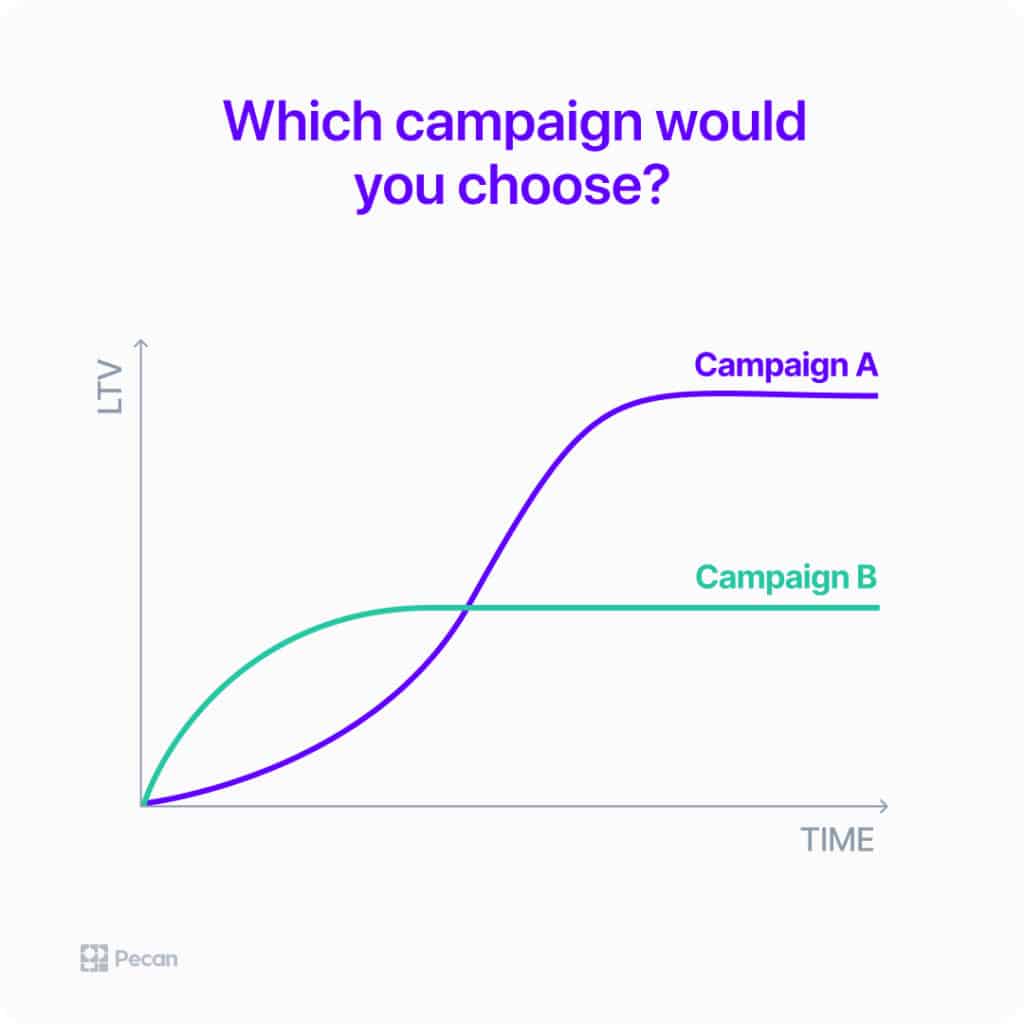[INT. A nondescript office.]
The marketer stares at a computer monitor displaying rows of conversion, ROAS, and cost-per-purchase data. The mouse cursor hovers indecisively over an on/off switch for a Facebook ad set.
A single tear catches the light from the screen as it rolls down the marketer’s face.
The fatal click echoes through the office: A campaign has been killed.
THE END
Except … that’s not the end of the story, of course. This difficult decision to kill campaigns — or, on the happier flip side, to invest more in a high-performing campaign — is all part of executing a successful marketing strategy.
But the information available from platforms about past campaign performance is typically not well-suited to guide this decision. As a result, marketers end up operating on a combination of data and unavoidably flawed human reasoning. That approach may provide acceptable results but also wastes a lot of resources.
In a recent blog post, we talked about how digital marketers must adopt a responsive, genuinely data-driven approach to managing advertising campaigns in order to thrive in today’s market conditions. So let’s dig into why marketing decision-making is so challenging and explore solutions that can make campaign decisions more clear-cut, confident, and efficient.
Which campaigns are killing it — or need to be killed?
With the data you receive from ad platforms and other sources, you may feel poorly prepared to decide which campaigns should be killed and which should be scaled to provide an even more significant impact. You know most campaigns probably aren’t efficient enough and aren’t immediately returning the return on ad spend (ROAS) you want to see — but some might blossom to perform very well, given the time to mature. But which campaign fits in which category?
The reality is that precious resources are often wasted as marketers wait for enough data to feel at least somewhat well-informed about these critical decisions. Part of the challenge is that truly understanding a campaign’s ROAS lies in calculating its actual return over an extended period. But marketers usually can’t anticipate that longer-term result due to the limitations of the data most often used for this decision.
For example, Google Ads and Facebook can provide data on the value of customers acquired by a campaign for 7 days after the campaign begins. But what if a campaign takes more than 7 days to gain momentum before it shows its true value? You might kill what appears to be an underperforming campaign that just needed a bit more time for payback (and then some).
Similarly, you might see fantastic revenue generated within the first 7 days of a campaign and dump more resources into it, only to see it fade fast and generate a disappointingly low long-term return.
While Campaign A doesn’t look as promising as Campaign B in the short term, it offers far greater value in the long run. Predictive analytics can help marketers foresee these differences over time and put more money into their more rewarding campaigns. Just as importantly, they can avoid wasting resources on underperforming campaigns.
The point here is that ad platforms don’t help you determine a campaign’s likely ROAS as quickly as possible so that you can reach your goals as soon as possible. You want to make decisions fast and put your money where it will matter most. But doing that without a more reliable source of guidance regarding long-term outcomes is little better than guesswork.
Throwing good money after bad in campaigns
Another challenge of decision-making regarding marketing campaigns is avoiding the sunk-cost fallacy trap.
The sunk cost fallacy refers to humans’ tendency to want to continue investing time and money into something fundamentally flawed just because they’ve already put so much into it. So instead of cutting their losses and moving on to a new project that might be a better use of their resources, they continue to try and try to make the original project succeed against all odds.
A “sunk cost” is just what it sounds like: time or money you’ve already spent. The sunk-cost fallacy is when you tell yourself that you can’t quit because of all that time or money you spent. We shouldn’t fall for this fallacy, but we do it all the time.
– Stephen Dubner, Freakonomics
It’s an understandable impulse, but in marketing, time and money are in short supply, especially in our current market conditions.
Today’s marketers need to cultivate a healthy objectivity about their campaigns. You can develop that attitude by adopting a data-driven approach to evaluating ad campaigns at the earliest opportunity. Then, you can make decisions about the right next actions as soon as possible to conserve resources and increase your ROAS.
Unfortunately, the outdated approach to campaign assessment currently used by many marketers — a reliance on short-term data about how audiences responded in the past to campaigns — reinforces the tendency to fall victim to the sunk cost fallacy.
If you’re focused on how things went in the recent past and spend a lot of time looking at short-term data, you’ll naturally want to cling to any signs of success you can identify. It’s just how humans think. We want to find success when something we invested in is on the line.
When something “looks” successful in the short term, the natural response is to throw more money at it and — perhaps mistakenly — divest from other campaigns that don’t look as immediately successful.
How a future-focused approach guides confident decisions
A better approach that can help circumvent this problematic thinking is to adopt a future-driven approach to evaluating campaigns. Instead of studying what happened in the past, you can examine what’s most likely to happen in the future, particularly the campaign outcomes that matter most to you.
AI-powered predictive analytics (our favorite!) makes this evaluation possible in ways that rule-based BI approaches can only dream of.
For example, you can use early data from a new campaign’s first 24-48 hours to predict the value (LTV) of customers’ activity with your business during that campaign. You could predict that total value during the coming 30, 60, 90, or 180 days. That perspective might reveal that campaigns you didn’t expect to be successful in the short term are likely to return far greater value over a longer period.
This future-focused approach can provide far greater clarity on the long-term value of your marketing campaigns and investments. Rather than just knowing what’s already occurred, you can glimpse the likely ROAS of your campaign — even up to 6 months out. This information is critical for teams wanting to increase marketing campaigns’ ROAS.
… we may want to use technologies to help us make decisions when it comes to scenarios where we might be influenced by the sunk cost fallacy. – The Decision Lab
Get started today and let your data drive results in weeks
Additionally, predictive analytics can generate a far more granular understanding of your campaigns than you can obtain with the built-in, opaque tools provided by the ad platforms or from typical BI data.
For instance, you can predict the long-term value of each and every customer acquired by a campaign. That customer-level prediction allows you to create more accurate customer segments, then strategically deepen your relationship with each group. You can identify future VIPs, refine your messaging, and provide personalized offers for your products and services with these more-trustworthy segments. All of these efforts will improve your ROAS.
Better-performing campaigns while preserving your processes
All this isn’t to say that your current data and dashboards are worthless. It’s that they aren’t currently providing the most important perspective that informs your campaigns’ success: foresight into those campaigns’ future.
However, you might be surprised that it can be relatively easy to integrate predictions into your existing data stack and visualizations. Predictive analytics platforms like Pecan can integrate their output directly into your BI dashboards, CRM, CDP, MMP, or ad platforms. That means you can get information about the future right in the same places you would normally examine your campaigns’ performance. It’s like building a little time machine right into your dashboards.
Adopting a future-driven approach to campaign management doesn’t have to involve a massive digital transformation project. It can be a fast, seamless process that will transform your business outcomes, but not your familiar workflows. You’ll see the impact on the quality and confidence of your campaign management decisions — and you’ll appreciate the significant boost to your ROAS.
In today’s fast-changing marketing environment, it’s time to equip yourself with every tool possible to guide your decisions. Get in touch to talk about how predictive analytics can help you manage your digital marketing campaigns so they can achieve their maximum potential more quickly and efficiently than ever before.






